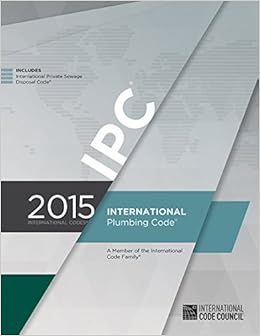The 2015 International Plumbing Code (IPC) has been out since the summer of 2014 and for the first time it has expanded the approved types of grease interceptors to include gravity grease interceptors (GGI) and fats, oils and grease (FOG) disposal systems.
Lets take a look at what's changed and note some problems that will have to be addressed.
 Section 1003.3.6 was added to the code as a distinct new category for grease interceptors titled, "Gravity grease interceptors and gravity grease interceptors with fats, oils and greases disposal systems."
Section 1003.3.6 was added to the code as a distinct new category for grease interceptors titled, "Gravity grease interceptors and gravity grease interceptors with fats, oils and greases disposal systems."Note that these are actually two different categories for gravity interceptors with different requirements for approval.
- GGIs are required to comply with IAPMO/ANSI Z1001
- GGIs with FOG disposal systems are required to comply with ASME A112.14.6.
I have covered all of the recognized standards for grease interceptors previously here: http://theinterceptorwhisperer.blogspot.com/2014/03/the-standards-that-govern-grease.html
As I explain in the post linked above, IAPMO/ANSI Z1001 doesn't have a performance test protocol, but rather only mandates leak testing.
Another problem with the standard is that it doesn't provide any sizing guidelines, which forces specifiers to look elsewhere for help sizing these devices.
The problem with the 2015 IPC is that it doesn't adequately address sizing of GGIs in the new section. Here is what it says, "the required capacity...shall be determined by multiplying the peak drain flow into the interceptor in gallons per minute by a retention time of 30 minutes."
Okay, so which method is approved for determining the peak drain flow into the interceptor?
It doesn't say.
I can outline the options for you though:
Fixture volume
The formula for determining the flow rate from a fixture is as follows: (((LxWxH)/231)*0.75)/1 (1 minute) or (((LxWxH)/231)*0.75)/2 (2 minute).
Calculate the flow rate from each fixture connecting to the interceptor and sum them together and then add the flow rates from any other fixtures, such as dishwashers or woks, etc. This is the maximum flow rate to the interceptor.
Pipe diameter
Using pipe diameter is another method for determining the peak flow rate into an interceptor. Pipe diameters in gravity drainage systems are determined by drainage fixture units (DFU) according to chapter 7 of the code. Maximum DFUs are calculated to ensure that the pipe will never be more than 50% full during peak flow periods. Maximum flow rates in horizontal drainage piping is calculated by Manning's Formula with the following results:

The design flow or half pipe flow values should be selected for sizing GGIs since they represent the peak horizontal flow for each pipe diameter.
The real fun begins when you actually take the peak flow rate you have selected and multiply it by a 30 minute retention time.
This will raise all kinds of interesting questions that your local plumbing inspector may have to answer:
- When using fixture volume sizing, if the jurisdiction requires a one minute drainage period calculation, how do you account for intermittent use of all of the connected fixtures, since the calculation doesn't account for it?
- Are you allowed to use a two minute drainage period for fixture volume calculations?
- Are you allowed to use a two minute drainage period for pipe diameter calculations?
- What if the jurisdiction mandates 6" diameter drainage piping outside of the building, requiring 6" connections on the interceptor; do you use pipe diameter or fixture volume sizing?
ASME A112.14.6 does not mandate gravity grease interceptors as the required type of interceptor. In fact the standard requires separation/retention efficiency in accordance with ASME A112.14.3 which GGIs are not required to be tested and rated to.
The last area of concern in the 2015 IPC is section 1003.3 which states, "Grease Interceptors shall comply with the requirements of sections 1003.3.1 through 1003.3.5, leaving out the new section 1003.3.6.
This oversight leaves the specifier with unclear and vague requirements as stated under 1003.1 and 1003.2 only. Thus while hydromechanical grease interceptors and automatic grease removal devices have clear requirements spelled out regarding which fixtures are to be routed to them and how to handle food waste disposers and dishwashers, GGIs have no stated requirements.
Hey, even if you get all of that down for your project, regardless how you determine the size of the grease interceptor, how does an owner know that the interceptor is the right one for his facility?
Oh yeah, that's why we developed the Grease Production Sizing Method!
This is not as complicated as one might be led to believe. FOG Disposal Systems [ASME A112.14.6] applied to GGIs is a feature, not a type.
ReplyDeleteSizing of a particular interceptor is no different whether it is a standard interceptor, or has features such as GRD [Grease Removal Device] or FOG Disposal System.
Peak flow calculations are based on two very simple truths:
1. Fixture Capacity (not to be confused with Drainage Fixture Units - DFU) plus hydrant production. Used in built facilities where the appliance compliment is known - a facility cannot discharge more water than it has. Expressed in GPM.
2. Pipe Capacity (full). Used in before built circumstances where the appliance compliment is not yet known - a facility cannot discharge more water than the connected pipe will carry. Expressed in GPM.
Retention time is factored in the case of Gravity Grease Interceptors.
Peak velocity is used because velocity is the parameter which determines suspension transport.
Regards,
Max Weiss, Executive Director
Plumbing & Drainage Instutute
Using pipe diameter is another method for determining the peak flow rate into an interceptor.
ReplyDelete